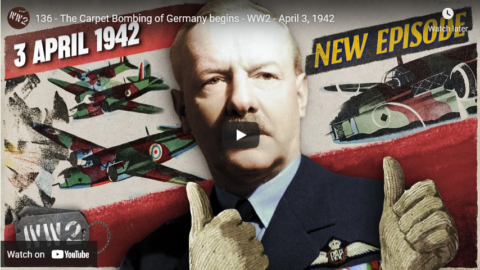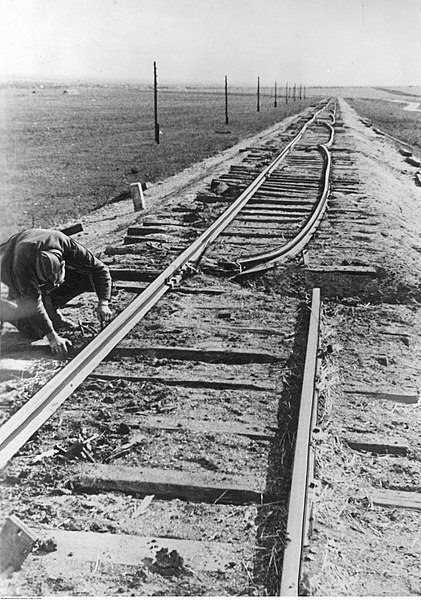World War Two
Published 3 Apr 2021Britain’s campaign to firebomb the old towns of Germany where civilians reside begins in earnest this week. The British also destroy the port at St. Nazaire in commando action. In the Indian Ocean, however, they are avoiding contact with the Japanese, even while on land the Japanese advance in both Burma and New Guinea.
Check out Indy’s Tie Barn to get your own tie right here: https://www.youtube.com/c/IndysTieBar…
Join us on Patreon: https://www.patreon.com/TimeGhostHistory
Or join The TimeGhost Army directly at: https://timeghost.tvFollow WW2 day by day on Instagram @ww2_day_by_day – https://www.instagram.com/ww2_day_by_day
Between 2 Wars: https://www.youtube.com/playlist?list…
Source list: http://bit.ly/WW2sourcesWritten and Hosted by: Indy Neidell
Director: Astrid Deinhard
Producers: Astrid Deinhard and Spartacus Olsson
Executive Producers: Astrid Deinhard, Indy Neidell, Spartacus Olsson, Bodo Rittenauer
Creative Producer: Maria Kyhle
Post-Production Director: Wieke Kapteijns
Research by: Indy Neidell
Edited by: Iryna Dulka
Sound design: Marek Kamiński
Map animations: Eastory (https://www.youtube.com/c/eastory)Colorizations by:
– Daniel Weiss
– Carlos Ortega Pereira, BlauColorizations – https://www.instagram.com/blaucolorizations
– Election1960 from Wiki CommonsSources:
– Bundesarchiv – 101II-MW-3722-03
– IWM C 2351, A 11787, H_018753_1, R 1827Soundtracks from the Epidemic Sound:
– Rannar Sillard – “Easy Target”
– Edward Karl Hanson – “Spellbound”
– Phoenix Tail – “At the Front”
– Jo Wandrini – “Dragon King”
– Phoenix Tail – “Last Minute Reaction”
– Craft Case – “Secret Cargo”
– Fabien Tell – “Last Point of Safe Return”
– Howard Harper-Barnes – “Underlying Truth”
– Flouw – “A Far Cry”
– Fabien Tell – “Break Free”
– Wendel Scherer – “Time to Face Them”Archive by Screenocean/Reuters https://www.screenocean.com.
A TimeGhost chronological documentary produced by OnLion Entertainment GmbH.
April 4, 2021
The Carpet Bombing of Germany begins – WW2 – 136 – April 3, 1942
The Good Idea Fairy Strikes: American Trowel Bayonets
Forgotten Weapons
Published 13 Nov 2017The United States first experimented with a combination trowel and bayonet in 1868, producing 200 experimental examples made from standard socket bayonets. This was immediately followed by an additional 500 Model 1869 trowel bayonets made new. These were distributed to a few companies of the infantry to test in the field. Remarkably, the trials reports were overwhelmingly positive.
The US infantryman at that time did not carry any sort of entrenching tool, and so even an awkward combination tool was an improvement over a canteen cup or other ad hoc tool for digging. The bayonet was seen by some officers as becoming obsolete with the introduction of breechloading rifles, so the reduced effectiveness of the new item as a bayonet was not a substantial concern. The intended use of these tools was not to dig elaborate trenches, but rather to hastily construct a shallow ditch and embankment which would provide just enough cover to shelter a prone soldier.
With the trials reports in, the government purchased 10,000 of the improved 1873 pattern trowel bayonet, which featured a stronger blade and a much more comfortable handle for digging. These were issued and used in the field (and in several combat engagements), but the developmental direction turned towards combination knife trowels instead of bayonets, and there would be no further development or issue of these tools after the 1870s.
See the full trials report here: https://books.google.com/books?id=qUE…
http://www.patreon.com/ForgottenWeapons
Cool Forgotten Weapons merch! http://shop.bbtv.com/collections/forg…
If you enjoy Forgotten Weapons, check out its sister channel, InRangeTV! http://www.youtube.com/InRangeTVShow
QotD: Revolution and civil war
I was a crew chief on Blackhawks, in an air assault company. Our job was to fly the infantry troops around and put them where they needed to be. A lot of the time, we would fly through the hills north of [Camp] Bondsteel. When we went that way, we usually flew over a mass grave. One morning, Serb gunmen showed up in a little Albanian village in the hills. They drove everyone out of their homes, forced them to dig their own graves, and then murdered them. Men, women and children. Fathers, mothers, sons, daughters, grandparents.
There was a little memorial with flowers.
Whenever someone starts talking about maybe voting is useless and perhaps other means are necessary to take back our country, I think of Kosovo. That EXACT rhetoric was part and parcel with the disintegration of the Balkans. The rhetoric I see people casually bandying about, we need to confront them everywhere and they deserve no peace, this is the rhetoric and the justification the Serbs used on their way to killing a quarter of a million people in the Balkans. Their former neighbors; often literally.
It’s worth considering whether all those who killed people in Kosovo started with killing in mind, or were they merely trying to right the wrongs that the other side had perpetrated against them? Civilization is a millimeters thin veneer on top an ocean of violence a billion years of evolution deep. If you think it’s acceptable to use violence for political gain, or if you fantasize for revolution, you’re a monster.
Revolution is not what you think it is. Revolution is civil war. Civil war is driving your neighbors from their homes and forcing them to dig their own graves. It is leaving your grandmother behind because she cannot move fast enough to escape the gunmen; and they won’t stop. Yes, there are monsters in places of power, but you are not absolved of your obligations to humanity because of it. That others have foresworn theirs is no excuse. You fetishize misery you cannot fathom. You are in good company, we are all monsters in civilized clothes; do not be insulted or ashamed.
Endeavor to be more.
Again.
Please.
John Chmelir (@JohnChmelir), Twitter (part of a 20-tweet thread), 2018-10-20.






